Hardware & Electrical System
Stage 4 – Hardware, Communications & Electrical Fit-Out
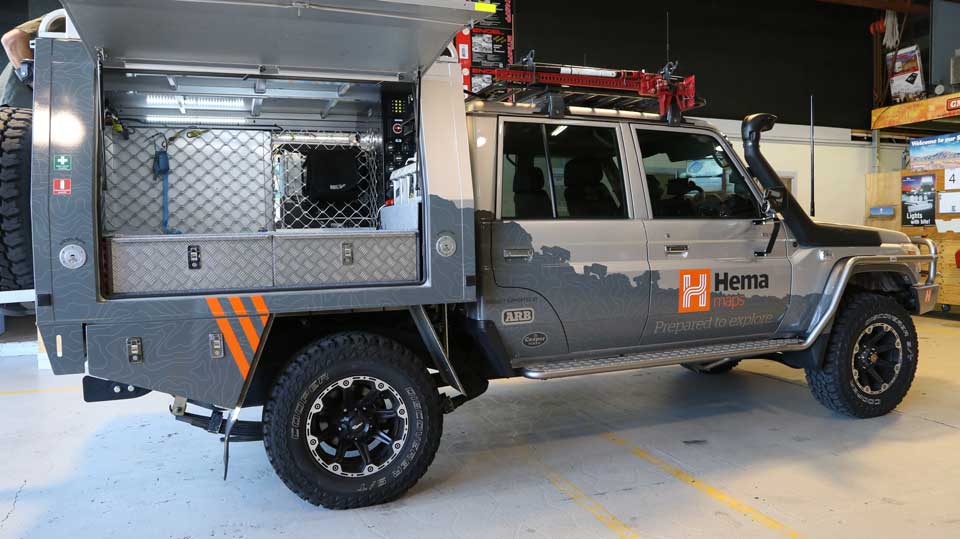 The 4x4 accessories are installed, the canopy has been made and fitted, but it’s our LandCruiser 79’s final build stage that shapes as its most defining transformation.
The 4x4 accessories are installed, the canopy has been made and fitted, but it’s our LandCruiser 79’s final build stage that shapes as its most defining transformation.
Self-sufficiency in the field is the cornerstone of what makes the Map Patrol a true expedition vehicle. For Hema’s field teams, this means complete independence to live and work in remote areas for extended periods. While off-road capability and storage are important parts of the LandCruiser’s job description, both are meaningless without ongoing power for mapping equipment and day-to-day living. This means that, in reality, this build stage is the difference between our LandCruiser being a capable off-road tourer and a real Map Patrol vehicle.
To bridge that gap, we took the 79 Series to GlobalSat, who are experts in communications and auto-electrics. GlobalSat are responsible for designing and implementing the LandCruiser’s entire power management system, as well as installing the mapping, communications and other electronic equipment that will feed off of it.
Batteries and Power Management System
The foundation of any auxiliary power management system is the power bank it’s drawing from. For the Map Patrol, this means having enough auxiliary power for Hema’s field teams to live and work on the road day-in and day-out, for weeks at a time. To cover our power demands, GlobalSat installed two Revolution 150 amp-hour lithium ion phosphate batteries at the front of the canopy, which were preferred to standard AGM or lead-acid for several reasons. In comparison to more common battery types, lithium ion batteries have a deeper discharge cycle, creating more usable power in each charge. They also charge faster, have a significantly longer lifespan, and weigh half as much as other batteries of the same size – all huge advantages for keeping the Map Patrol light and efficient in the field.
Charging this power bank is a Redarc Manager30, which will take charge from the vehicle while it is running, from 240-volt mains power, or directly from solar panels (which it can do simultaneously while prioritising solar input). To quickly check the batteries’ status, the Manager30 comes with a remote monitor that displays helpful information such as state of charge, current voltage and remaining power (expressed in days and hours), giving our expedition team peace of mind at a glance. The Manager30 also has an in-built battery isolation function, meaning at a preset level of discharge, the system will stop distributing power to protect the batteries from excessive discharge. If it disconnects power at a critical point, GlobalSat have installed a separate isolator to override the original system, allowing our field team to keep running for a short time. Yet another Redarc battery isolator is under the bonnet of the LandCruiser 79 too, which links the starter battery to a supporting battery that will act as a failsafe in case of an emergency.
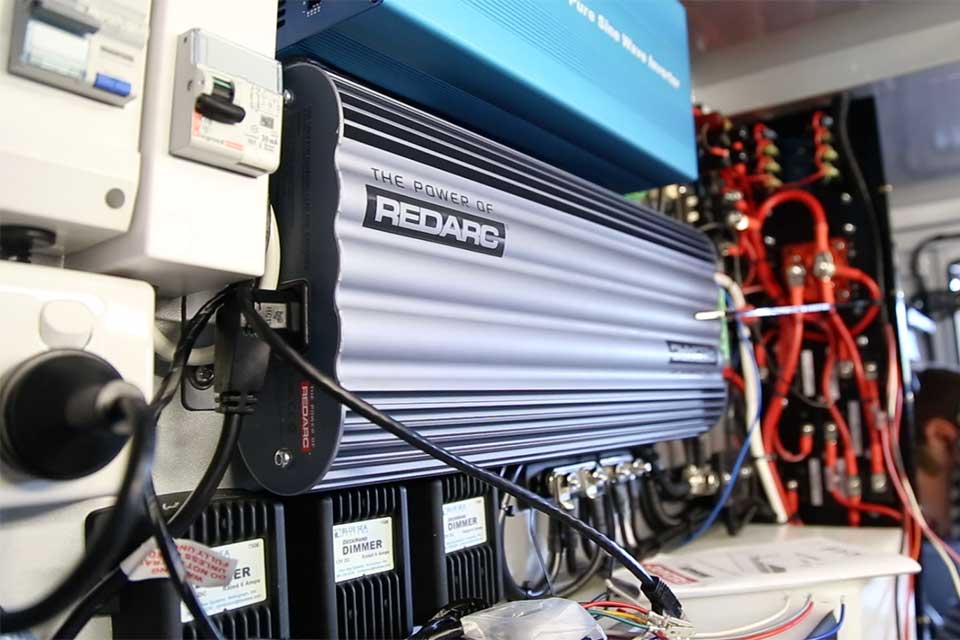
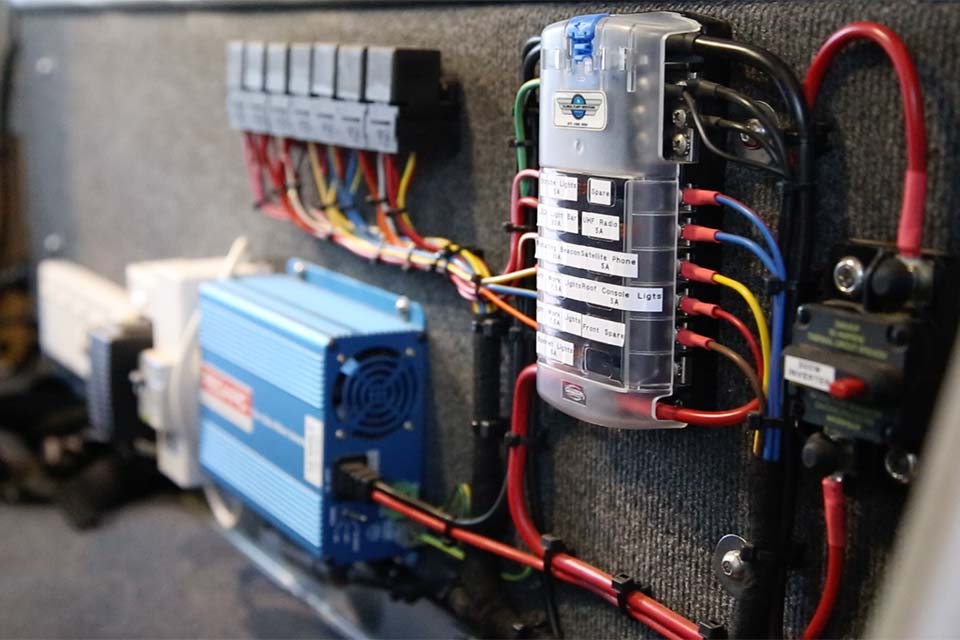 ABOVE: The 240-volt power distribution point in the cabin, with a Cotek 300-Watt inverter and individually fused circuits to make the system more robust.
ABOVE: The 240-volt power distribution point in the cabin, with a Cotek 300-Watt inverter and individually fused circuits to make the system more robust.
Power Distribution
The LandCruiser’s impressive battery management system is a reflection of its power needs, which includes countless devices and hardware that are integral to our data collection process. All told, there are 47 circuits carrying power from the system, each one responsible for an individual task. Each circuit uses marine grade cabling to guard against water and dust ingress, and all are individually fused and colour-coded. In practical terms, this means that when a fuse blows, it only cuts power to that specific load without affecting the rest of the system. This enables our team to remain operational in the midst of an electrical fault, while allowing them to find the source of any problem instantly. This careful segmentation ruggedizes the entire system, and is indicative of just how much equipment GlobalSat has installed in the LandCruiser.
Starting with the driver’s side of the canopy, GlobalSat have created a dedicated charging bay for video and still cameras, laptops and other devices while not on the move, as well as to charge up power tools such as a drill if required. All 240-volt items in the canopy will take their charge from a 1000-watt inverter, which is hidden behind the custom panel that houses the main power management system, and is protected by an RCD and MEN link for extra safety compliance. The charging bay is complete with DC power through 16 USB ports at 2 amp-hour each, AC power from two power boards, and two mounted chargers for powering DSLR camera batteries. On the kitchen side is the Engel 80L upright fridge and switches for the air compressor and vehicle lighting, along with dimmers for the canopy’s interior lighting. Speaking of lighting, GlobalSat have installed two rear LED work lights, two side work lights and two light bars around the exterior of the LandCruiser, giving our expedition team the ability to turn night into day either on the road or at camp.
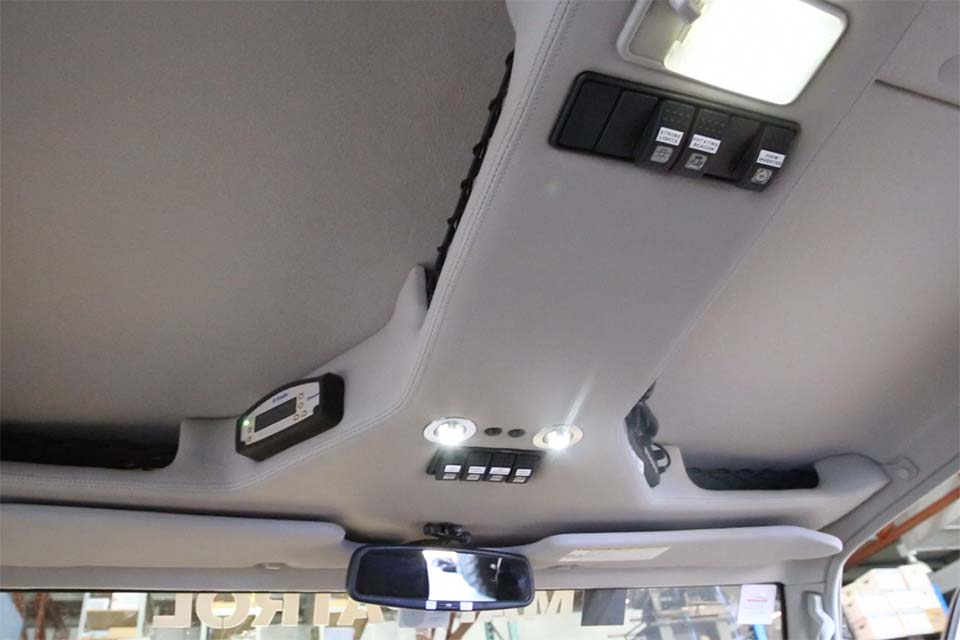
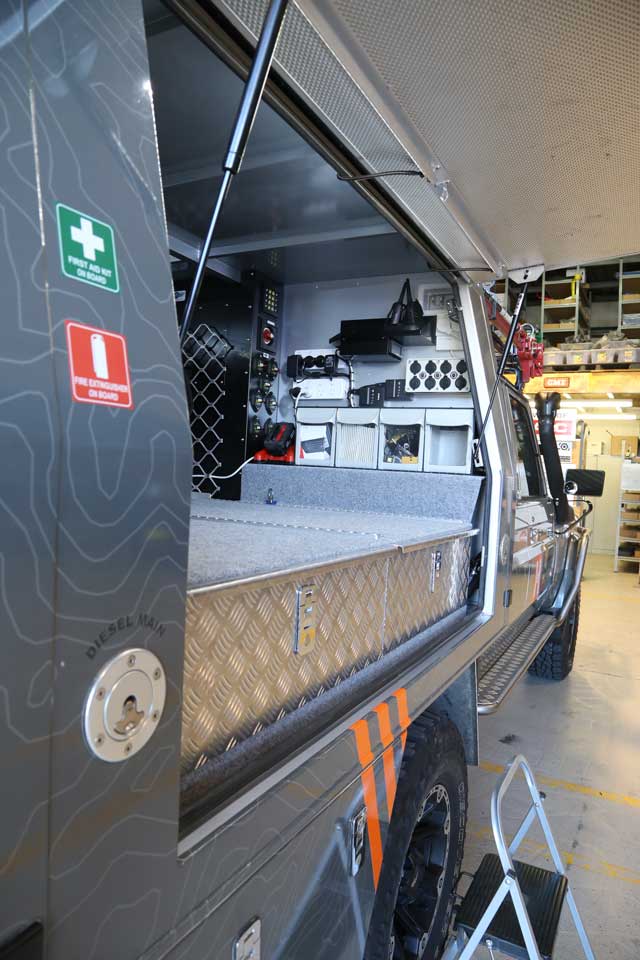
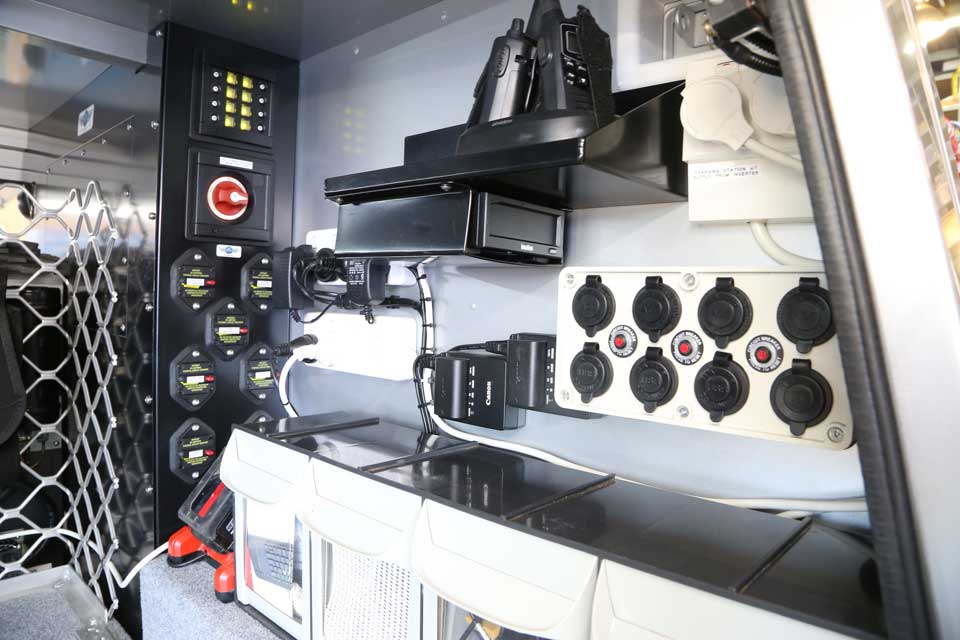 TOP: The Department of the Interior custom roof console houses light switches, the differential GPS receiver and the GME UHF radio to save space and help organise the electrical hardware in the cabin.
TOP: The Department of the Interior custom roof console houses light switches, the differential GPS receiver and the GME UHF radio to save space and help organise the electrical hardware in the cabin.
ABOVE: The driver side canopy charging bay, complete with AC and DC power, mounted camera chargers and a hard drive for storing mapping data.
Moving into the cabin where most of the hardware was installed, the difference between a normal tourer and a Map Patrol becomes most apparent. Against the back wall is a 300-watt inverter to power 240-volt equipment in the cab, which will be primarily for mobile phones, tablets and navigation gear while the expedition team is on the move. In the front, starting on the driver’s side are gauges to monitor boost, EGT, water temperature, voltage of both the start and auxiliary batteries, as well as full amperage capacity of the vehicle at any one time. Below the gauges are a host of switches to give the driver immediate control over a variety of electrical functions: one to link the under-bonnet auxiliary and starter batteries, one for the LED driving lights, and another to switch between the vehicle-mounted and Patriot camper trailer reversing cameras for when the LandCruiser is towing. Also for towing is a dial to use the Redarc Tow-Pro electric trailer brake controller.
On the opposite side of the steering wheel is a low coolant alarm as well as an alarm for the canopy doors, which both sit underneath the Havis dock that houses the Map Patrol’s Panasonic Toughpad. The Toughpad is what our expedition team uses to capture mapping data, which is intermittently backed up to a hard drive mounted in the glove box. Below the Havis is a docked Iridium satellite phone, along with a dock for the Map Patrol’s dedicated smartphone. Both the satellite phone and the smartphone docks are linked to separate antennas mounted on the roof of the LandCruiser, which boost each phone’s signal in remote areas. Also on the roof is a differential GPS aerial that’s linked to the Toughpad, with the aerial mounted in the exact centre of the roof to optimise its half-metre accuracy that makes every Hema map so precise.
While the differential GPS aerial is on the roof, the receiver is inside the cabin, tucked away behind a Department of the Interior custom made roof console that also houses the Map Patrol’s UHF radio. The roof console also three dual USB sockets has switches for the LandCruiser’s external work lights, and in-built map lights for the front and a small LED for the back seats. Finally, in front of the roof console is an ARB reversing camera monitor, which can be switched between the vehicle and camper trailer cameras depending if the LandCruiser is towing or not. A Department of the Interior floor console with drink holders and an additional three USB sockets finishes the cabin transformation.
With all that work done, our LandCruiser build is now complete. More importantly, our LandCruiser 79 Dual Cab is now a true Map Patrol vehicle. With tyres and 4x4 accessories to take it anywhere, a functional canopy to act as a rugged home office, and a highly sophisticated electrical system to keep our expedition team working and self-sufficient for weeks on end, this is our most powerful Map Patrol vehicle ever - and officially Australia’s toughest mapping machine.
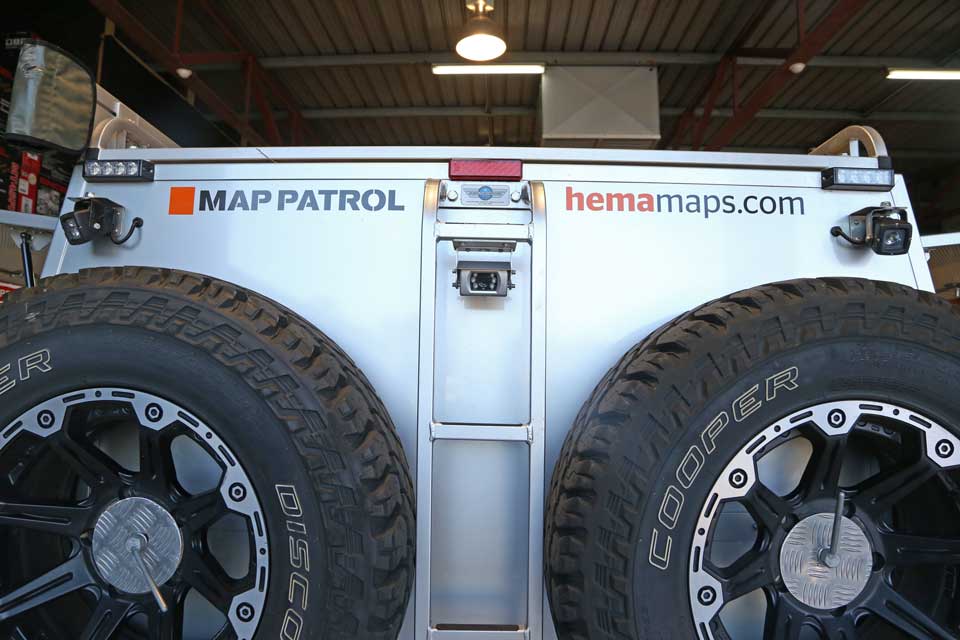










0 comments